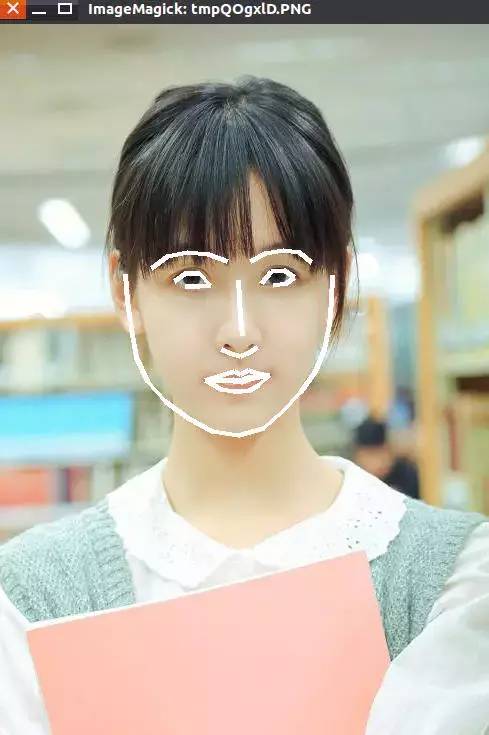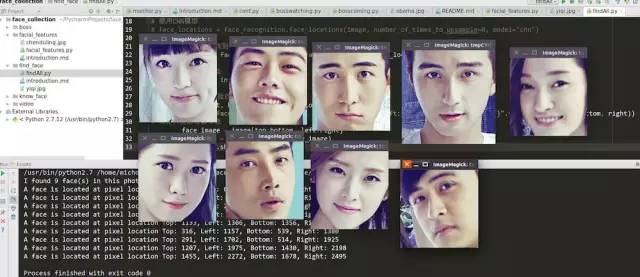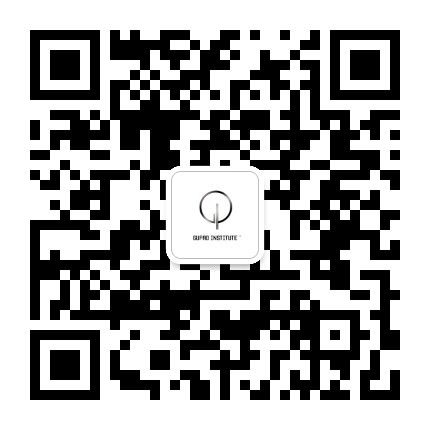一、环境搭建
1.系统环境
Ubuntu17.04
Python2.7.14
pycharm开发工具
2.开发环境,安装各种系统包
人脸检测基于dlib,dlib依赖Boost和cmake
在windows中如果要使用dlib还是比较麻烦的,如果想省时间可以在anaconda中安装
conda install -c conda-forge dlib=19.4
$ sudo apt-getinstallbuild-essential cmake
$ sudo apt-getinstalllibgtk-3-dev
$ sudo apt-getinstalllibboost-all-dev
其他重要的包
$ pip install numpy
$ pip install scipy
$ pip install opencv-python
$ pip install dlib
安装 face_recognition
# 安装 face_recognition
$ pip install face_recognition
# 安装face_recognition过程中会自动安装 numpy、scipy 等
二、使用教程
1、facial_features文件夹
此demo主要展示了识别指定图片中人脸的特征数据,下面就是人脸的八个特征,我们就是要获取特征数据
'chin',
'left_eyebrow',
'right_eyebrow',
'nose_bridge',
'nose_tip',
'left_eye',
'right_eye',
'top_lip',
'bottom_lip'
运行结果:
自动识别图片中的人脸,并且识别它的特征
原图:
特征数据,数据就是运行出来的矩阵,也就是一个二维数组
代码:
# -*- coding: utf-8 -*-
# 自动识别人脸特征
# filename : find_facial_features_in_picture.py
# 导入pil模块 ,可用命令安装 apt-get install python-Imaging
fromPILimportImage, ImageDraw
# 导入face_recogntion模块,可用命令安装 pip install face_recognition
importface_recognition
# 将jpg文件加载到numpy 数组中
image = face_recognition.load_image_file("chenduling.jpg")
#查找图像中所有面部的所有面部特征
face_landmarks_list = face_recognition.face_landmarks(image)
print("I found {} face(s) in this photograph.".format(len(face_landmarks_list)))
forface_landmarksinface_landmarks_list:
#打印此图像中每个面部特征的位置
facial_features = [
'chin',
'left_eyebrow',
'right_eyebrow',
'nose_bridge',
'nose_tip',
'left_eye',
'right_eye',
'top_lip',
'bottom_lip'
]
forfacial_featureinfacial_features:
print("The {} in this face has the following points: {}".format(facial_feature, face_landmarks[facial_feature]))
#让我们在图像中描绘出每个人脸特征!
pil_image = Image.fromarray(image)
d = ImageDraw.Draw(pil_image)
forfacial_featureinfacial_features:
d.line(face_landmarks[facial_feature], width=5)
pil_image.show()
2、find_face文件夹
不仅能识别出来所有的人脸,而且可以将其截图挨个显示出来,打印在前台窗口
原始的图片
识别的图片
代码:
# -*- coding: utf-8 -*-
# 识别图片中的所有人脸并显示出来
# filename : find_faces_in_picture.py
# 导入pil模块 ,可用命令安装 apt-get install python-Imaging
fromPILimportImage
# 导入face_recogntion模块,可用命令安装 pip install face_recognition
importface_recognition
# 将jpg文件加载到numpy 数组中
image = face_recognition.load_image_file("yiqi.jpg")
# 使用默认的给予HOG模型查找图像中所有人脸
# 这个方法已经相当准确了,但还是不如CNN模型那么准确,因为没有使用GPU加速
# 另请参见: find_faces_in_picture_cnn.py
face_locations = face_recognition.face_locations(image)
# 使用CNN模型
# face_locations = face_recognition.face_locations(image, number_of_times_to_upsample=0, model="cnn")
# 打印:我从图片中找到了 多少 张人脸
print("I found {} face(s) in this photograph.".format(len(face_locations)))
# 循环找到的所有人脸
forface_locationinface_locations:
# 打印每张脸的位置信息
top, right, bottom, left = face_location
print("A face is located at pixel location Top: {}, Left: {}, Bottom: {}, Right: {}".format(top, left, bottom, right))
# 指定人脸的位置信息,然后显示人脸图片
face_image = image[top:bottom, left:right]
pil_image = Image.fromarray(face_image)
pil_image.show()
3、know_face文件夹
通过设定的人脸图片识别未知图片中的人脸
# -*- coding: utf-8 -*-
# 识别人脸鉴定是哪个人
# 导入face_recogntion模块,可用命令安装 pip install face_recognition
import face_recognition
#将jpg文件加载到numpy数组中
chen_image = face_recognition.load_image_file("chenduling.jpg")
#要识别的图片
unknown_image = face_recognition.load_image_file("sunyizheng.jpg")
#获取每个图像文件中每个面部的面部编码
#由于每个图像中可能有多个面,所以返回一个编码列表。
#但是由于我知道每个图像只有一个脸,我只关心每个图像中的第一个编码,所以我取索引0。
chen_face_encoding = face_recognition.face_encodings(chen_image)[0]
print("chen_face_encoding:{}".format(chen_face_encoding))
unknown_face_encoding = face_recognition.face_encodings(unknown_image)[0]
print("unknown_face_encoding :{}".format(unknown_face_encoding))
known_faces = [
chen_face_encoding
]
#结果是True/false的数组,未知面孔known_faces阵列中的任何人相匹配的结果
results = face_recognition.compare_faces(known_faces, unknown_face_encoding)
print("result :{}".format(results))
print("这个未知面孔是 陈都灵 吗? {}".format(results[0]))
print("这个未知面孔是 我们从未见过的新面孔吗? {}".format(not True in results))
4、video文件夹
通过调用电脑摄像头动态获取视频内的人脸,将其和我们指定的图片集进行匹配,可以告知我们视频内的人脸是否是我们设定好的
实现:
代码:
# -*- coding: utf-8 -*-
# 摄像头头像识别
import face_recognition
import cv2
video_capture = cv2.VideoCapture(0)
# 本地图像
chenduling_image = face_recognition.load_image_file("chenduling.jpg")
chenduling_face_encoding = face_recognition.face_encodings(chenduling_image)[0]
# 本地图像二
sunyizheng_image = face_recognition.load_image_file("sunyizheng.jpg")
sunyizheng_face_encoding = face_recognition.face_encodings(sunyizheng_image)[0]
# 本地图片三
zhangzetian_image = face_recognition.load_image_file("zhangzetian.jpg")
zhangzetian_face_encoding = face_recognition.face_encodings(zhangzetian_image)[0]
# Create arrays of known face encodings and their names
# 脸部特征数据的集合
known_face_encodings = [
chenduling_face_encoding,
sunyizheng_face_encoding,
zhangzetian_face_encoding
]
# 人物名称的集合
known_face_names = [
"michong",
"sunyizheng",
"chenduling"
]
face_locations = []
face_encodings = []
face_names = []
process_this_frame = True
while True:
# 读取摄像头画面
ret, frame = video_capture.read()
# 改变摄像头图像的大小,图像小,所做的计算就少
small_frame = cv2.resize(frame, (0, 0), fx=0.25, fy=0.25)
# opencv的图像是BGR格式的,而我们需要是的RGB格式的,因此需要进行一个转换。
rgb_small_frame = small_frame[:, :, ::-1]
# Only process every other frame of video to save time
if process_this_frame:
# 根据encoding来判断是不是同一个人,是就输出true,不是为flase
face_locations = face_recognition.face_locations(rgb_small_frame)
face_encodings = face_recognition.face_encodings(rgb_small_frame, face_locations)
face_names = []
for face_encoding in face_encodings:
# 默认为unknown
matches = face_recognition.compare_faces(known_face_encodings, face_encoding)
name ="Unknown"
# if match[0]:
# name = "michong"
# If a match was found in known_face_encodings, just use the first one.
if True in matches:
first_match_index = matches.index(True)
name = known_face_names[first_match_index]
face_names.append(name)
process_this_frame = not process_this_frame
# 将捕捉到的人脸显示出来
for (top, right, bottom, left), name in zip(face_locations, face_names):
# Scale back up face locations since the frame we detected in was scaled to 1/4 size
top *= 4
right *= 4
bottom *= 4
left *= 4
# 矩形框
cv2.rectangle(frame, (left, top), (right, bottom), (0, 0, 255), 2)
#加上标签
cv2.rectangle(frame, (left, bottom - 35), (right, bottom), (0, 0, 255), cv2.FILLED)
font = cv2.FONT_HERSHEY_DUPLEX
cv2.putText(frame, name, (left + 6, bottom - 6), font, 1.0, (255, 255, 255), 1)
# Display
cv2.imshow('monitor', frame)
# 按Q退出
if cv2.waitKey(1) & 0xFF == ord('q'):
break
video_capture.release()
cv2.destroyAllWindows()
5、boss文件夹
本开源项目,主要是结合摄像头程序+极光推送,实现识别摄像头中的人脸。并且通过极光推送平台给移动端发送消息!
公众号:Python大咖那些事
关注领取更多资料,每日更新Python相关技术文!
Python开发学习交流群:705673780,一起学习交流哦







